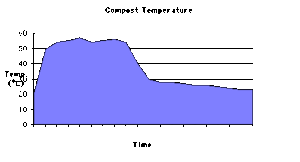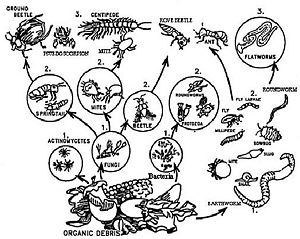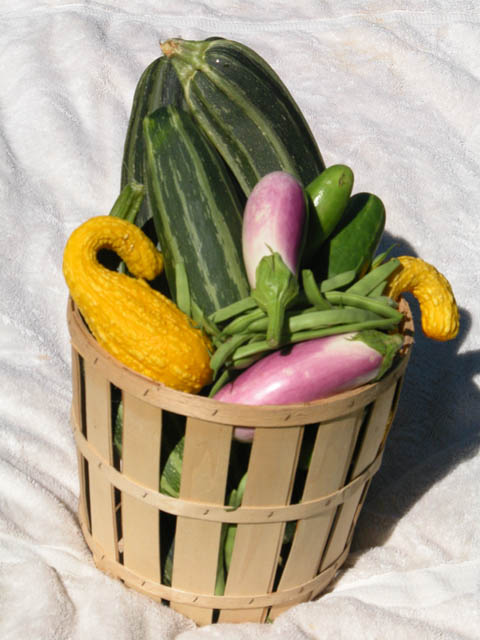Compost pile
Introduction
Compost is decomposition of Organic Matter such as kitchen scraps, wood shavings, yard trimmings, paper and cardboard. Compost supplies nutrients and advantageous life to the soil, develops better soil structure, and helps prevent overflow that can contaminate water streams such as rivers and lakes. Compost helps the soil soak up and preserve nutrients and provides plants protection from pests and diseases. Moreover, compost provides moisture which means less watering where you can conserve water and prevent river or lake pollution. Compost introduces and feeds diverse life in the soil, including bacteria, insects, worms, and more, which support vigorous, plant growth. Compost pile also helps yard protection during rainstorm. An excess of nutrients in water can deplete the oxygen available to fish and other aquatic life.1

Figure shows:Bacteria, fungi, and other microbes, these organisms make up a complex food web or energy pyramid with primary, secondary, and tertiary level consumers. The base of the pyramid, or energy source, is made up of organic matter including plant and animal residues. Organic residues such leaves or other plant materials are eaten by some types of invertebrates such as millipedes, sow bugs, snails and slugs. These invertebrates shred the plant materials, creating more surface area for action by fungi, bacteria, and actinomycetes (a group of organisms intermediate between bacteria and true fungi), which are in turn eaten by organisms such as mites and springtails.2
Description of Niche
- Thermus
- Highest compost temperatures, bacteria of the genus Thermus. Gram-negative bacteria likes ideal growth temperature of between 70°C and 75 °C with pH range between 7.5 to 8.0.
- Brucella abortus
- Gram-negative rod shaped bacteria, does not contain flagella or pili, nor do they create capsule slime. In addition they does not produce spores. Brucella abortusare know as heterotrophic bacteria as they can use either anaerobic or aerobic respiration.
- Enterobacter cloacae
- A rod-shaped, gram-negative bacteria and likes to live in mesophilic temperature (below 40 °C)
- Methylococcus capsulatus
- Negative-gram bacteria that lives in thermophilic temperature (45°C). They are closely related to Enterobacter cloacae. Methanotrophic bacteria is able to generate the greenhouse gas, methane, as an energy source for growth.8 Methanotrophs are a physiologically distinct group of bacteria characterized by their ability to use methane as the sole source of carbon and energy.Composting is a self-heating, aerobic microbial decomposition of organic materials. A typical composting process goes through a series of phases, including a rapid temperature increase, sustained high temperatures and a gradual cooling of the composting mass. Different microbial communities dominate during these various composting phases, each adapted to a particular environment 9
Pseudomonas stutzeri
- Gram-negative, rod-shaped, motile, single polar-flagellated, soil bacterium first isolated from human spinal fluid.3
Strain KC of P. stutzeri could be used for bioremediation as it can degrade carbon tetrachloride.4Pseudomonas stutzeri is not fluorescent like other members of genus Pseudomonas and are denitrifying bacterium.In spite of marked differences from the type strain of the genus, the sequence similarities of the rRNAs, demonstrated initially by DNA-rRNA hybridization, show the legitimacy of the inclusion of P. stutzeri in the genus Pseudomonas. Strains of the species have been identified among denitrifiers found in natural materials. Related species within the genus, such as P. mendocina, P. alcaligenes,P. pseudoalcaligenes, and P. balearica.5
Compost Temperature
In the process of composting, microorganisms shatter down organic matter by producing carbon dioxide, water, heat, and humus. Under optimal conditions, composting proceeds through three phases: 1) the mesophilic, or moderate-temperature phase, which lasts for a couple of days, 2) the thermophilic, or high-temperature phase, which can last from a few days to several months, and finally, 3) a several-month cooling and maturation phase.
Figure 2 Different communities of microorganisms predominate during the various composting phases. Starting decomposition carried by mesophilic microorganisms, which rapidly break down the soluble, readily degradable compounds. Temperature rises above 40°C, the mesophilic microorganisms become less competitive and are replaced by others that are thermophilic, or heat-loving. At temperatures of 55°C and above, many microorganisms that are human or plant pathogens are destroyed. High temperatures accelerate the breakdown of proteins, fats, and complex carbohydrates like cellulose and hemicelluloses, the major structural molecules in plants. Over 65°C kill many forms of microbes and limit the rate of decomposition, compost managers use aeration and mixing to keep the temperature below this point. Final phase of "curing" or maturation of the remaining organic matter.2
Who lives there?
- Bacteria
- Bacteria are single-celled and structured as either sphere-shaped cocci, rod-shaped bacilli, or spiral-shaped spirilla. majority of bacteria are motile, they have ability move under their own power. Predominate Mesophilic bacteria would process compost between 0-40°C. They are known to use variety enyzmes to chemically break down a variety of organic materials. Mostly found in topsoil. Thermophilic bacteria takes over when compost heat reaches above 40°C. The microbial populations during this phase are dominated by members of the genus Bacillus. Bacolli species can liv up to 50-50°C but dramatically decreases at 60°C or above. In unfavorable conditions, bacilli survive by forming endospores, thick-walled spores that are highly resistant to heat, cold, dryness, or lack of food. They are ubiquitous in nature and become active whenever environmental conditions are favorable.Thermus bacteria are found at highest compost temperature and accumulations of decomposing vegetation that have the proper conditions to heat up in compost pile. As the compost pile cools down, mesophilic bacteria again predominate. The longer the curing or maturation phase, the more diverse the microbial community it supports.
- Fungi
- Fungi plays important role as decomposing of comples plant polymers in soil and compost. Fungi includes molds and yeasts, in compost they break down tough debris, enabling bacteria to continue the decomposition process once most of the cellulose has been exhausted. Fungi grows rapidly by producing many cells and filaments, and they can attack organic residues that are too dry, acidic, or low in nitrogen for bacterial decomposition. Saprophytes because they live on dead or dying material and obtain energy by breaking down organic matter in dead plants and animals. Fungi are mostly found during both mesophilic and thermophilic phases of composting. During higher temperature they live on outer layer of compost. Scytalidium thermophilum helps in growth of thermophilic fungus.10
- Actinomycetes
- Actinomycetes are fungi resembled bacteria with filamentous. They are resistant to dry, acidic, or low in nitrogen for bacterial decomposition environment. Saprophytes because they live on dead or dying material and obtain energy by breaking down organic matter in dead plants and animals. Variety of Fungal Species are found during both mesophilic and thermophilic phases of composting. During higher temperature they like to live in the outer layer of compost.
- Protzoa
- Protozoa are one-celled microscopic animals. Mostly found in water droplets in compost but play a relatively minor role in decomposition. Protozoa obtain their food from organic matter in the same way as bacteria do but also act as secondary consumers ingesting bacteria and fungi.6
- Other Inverterbrates
- Ants makes compost richer in phosphorus and potassium by moving minerals from one place to another. Springtails one of the most important intertebrates as they help in breaking down materials They chew on decomposing plants, pollen, grains, and fungi. They also like to eat eat nematodes and droppings of other arthropods and then clean themselves after feeding. Snails and slugs likes fresh garbage so mostly found on top of compost pile. Centipedes are fast moving predators found mostly in the top few inches of the compost heap. They have formidable claws behind their head which possess poison glands that paralyze small red worms, insect larvae, newly hatched earthworms, and arthropods (mainly insects and spiders). Files are mostly found in mesophilic stage,they provide airborne transportation for bacteria. They also eat organic vegetation. Files larval phase (maggots) does not survive thermophilic temperatures.
Their incorporation into soil increases fertility (e.g. nitrogen fixers, nitrifiers, sulphur oxidizers), structure (e.g. exopolysaccharide producers), and can have other effects as a result of high activity and population levels, as well as through specific biochemical traits of the microorganisms.Increased numbers of microorganisms in compost also have an indirect role in improving plant health. Microorganisms form symbiotic associations with plant roots and synthesize and excrete nutrients (amino acids,vitamins), plant growth hormones and chelators, alter physical conditions to optimize plant growth, and decompose or neutralize toxic substances. The majority of bacteria isolated from composts were Gram-negative.7 Microorganisms may affect negatively as they compete for oxygen, nutrient which can inhibit metabolic products.
Current Research
microbes can strip out the oxygen in compost, within 15 minutes, there must be a constant flow of air through the compost, and far more than provided by passive aeration by convection Mother Natures Farm (Magic soil) is located in New york and they are currently working on three compost research silos that are specially modified for capturing the Surplus Microbial Metabolic Heat from early stage compost. Using compost (magic soil) and growing healthly organic food. "We expect to massively expand our Research growing, because demand for finished compost is totally dependant upon how well plants thrive in the finished product." Pathogens like E-Coli 0157 can easily be killed by the high temperatures easily achieved in well managed composting. How Much Air is Required to hold the CO2 level down to 2%? (oxygen level about 19%) Mother Nature are currently researching on how to get 200 times more fungal density than “normal” in the industry; enabling us to significantly speed up the composting process.
Summary
Antibiotic production is generally restricted in most soils due to the scarcity of nutrients 7
Acknowledgment
Thanks to Mr. John A. Crockett for sharing very informative information on Magic bio Soil(Mother Nature’s Farms, Inc). Their mission is to convert organic wastes into high quality soils and soil conditioners for all those involved in growing plants, landscapers, homeowners, and nurseries. We are committed to being a very good neighbor in the process, earning neighbor and community respect and support, not just tolerance. We will continue to do research in the areas of process and end product enhancement. As you can see the outcome of composting he was able to produce healthy food.
References
[1]Michaelides, Adam. Compost Education Program . 31 Dec 2007. 21 Aug 2008 <http://counties.cce.cornell.edu/tompkins/compost/Basics%20&%20Bennefits%20of%20Composting.pdf>.
[2]Olynciw, Nancy Trautmann and Elaina. Compost Microorganisms. 1995. 21 Aug 2008 <http://compost.css.cornell.edu/microorg.html>.
[3]Sijderius, R. "Heterotrophe bacterien, die thiosulfaat oxydeeren." Thesis, University Amsterdam, 1946, pp. 1-146
[4]Sepulveda-Torres, et al. (1999). "Generation and initial characterization of Pseudomonas stutzeri KC mutants with impaired ability to degrade carbon tetrachloride". Arch Microbiol 171 (6): 424–9. <http://www.ncbi.nlm.nih.gov/pubmed/10369898>.
[5]Jorge Lalucat, Antoni Bennasar, Rafael Bosch, Elena Garcı´a-Valde´s, and Norberto J. Palleroni. "Biology of Pseudomonas stutzeri." MICROBIOLOGY AND MOLECULAR BIOLOGY (2006): 510-547.<http://mmbr.asm.org/cgi/reprint/70/2/510>.
[6]Cornell Composting Science and Engineering. http://compost.css.cornell.edu/invertebrates.html. <http://compost.css.cornell.edu/invertebrates.html>.
[7]Jeanine I. Boulter, Jack T. Trevorsand Greg J. Boland. "Microbial studies of compost: bacterial identification, and their potential for turfgrass." World Journal of Microbiology & Biotechnology (2002): 661-671. < http://www.uoguelph.ca/~plpathol/PDFs/Boulter%20et%20al%20(2002)%20-%203.pdf>
[8]Brock, T. D Methylococcus capsulatus is a methane-oxidising bacterium that has great potential in bioremediation Vol. 5 pp.9-33. June 1st 2002.
[9]Dirk Halet, Nico Boon,and Willy Verstraete. "Community Dynamics of Methanotrophic Bacteria." JOURNAL OF BIOSCIENCE AND BIOENGINEERING (2006): 297-302.<http://www.jstage.jst.go.jp/article/jbb/101/4/101_297/_article>
[10]Wiegant, W. M. "Growth Characteristics of the Thermophilic Fungus Scytalidium thermophilum in Relation to Production of Mushroom Compost." Applied Environmental Microbiology (1992): 1301-1307<http://www.pubmedcentral.nih.gov/articlerender.fcgi?artid=195590>
Edited by [Natasha Naidu], students of Rachel Larsen




